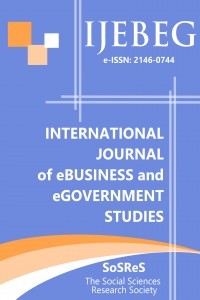ASSESSING E-GOVERNMENT SERVICE DELIVERY (GOVERNMENT TO CITIZEN)
ASSESSING E-GOVERNMENT SERVICE DELIVERY (GOVERNMENT TO CITIZEN)
e-government, e-services, quality assessment, e-tax,
___
- Amrit Tiwana and Balasubramaniam Ramesh. e-Services: Problems, opportunities Digital Platforms. In HICSS ’01: Proceedings of the 34th Annual Hawaii International Conference on System Sciences ( HICSS-34)- Volume 3, page 3018, Maui, Hawaii,
- January 2001. IEEE Computer Society. and American National Standards Institute, Software Engineering – Product Quality –
- Anand Agrawal et al.(2009) EGOSQ-Users’ Assessment of e-governance Online- Services, CSI India.
- Buckley, J, 2003, E-service quality and the public sector, Managing Service
- Quality Volume 13 · Number 6 · 2003 · pp. 453-462.
- C.N. Madu, and A.A. Madu, “Dimensions of e-quality”, International Journal of Quality & Reliability Management, (2002), Vol. 19, No. 3, pp. 246-259.
- Carbo, T., & Williams, J. G. (2004). Models and metrics for evaluating local electronic government systems and services. Electronic Journal of E-Government, 2(2), 95−104.
- Cox, J., and Dale, B.G. Service Quality and e-Commerce: An Exploratory Analysis, Managing Service Quality, 2001, 1 (2), -131.
- DeLone, W.H., and McLean, E.R., The DeLone and McLean Model of Information Systems Success: A Ten-Year Update, Journal of Management Information Systems, vol. (4):9-30, 2003.
- Essiscope, ISO 9126: the Standard of Reference (2006) [Available] Online at http://www.cse.dcu.ie/essiscope/sm2/9126ref.html, Accessed: September 22, 2006.
- Field, J.M., Heim, G.R., and Sinha, K.K. (2004), “Managing quality in the eservice system: Development and application of a process model”, Production and Operations
- Management, Vol. 13 No. 4, pp. 291306.
- Gounaris, S., Dimitriadis, S. and Stathakopoulos, V. (2005), “Antecedents of perceived quality in the context of Internet retail stores”, Journal of Marketing Management, Vol. No. 7, pp. 669682.
- ISO,9126, ISO 13407: Human-Centered Design Processes for Interactive Systems, 1999.
- Kim, M., Kim, JH., and Lennon, S.J. (2006), “Online service attributes available on apparel retail web sites: An ESQUAL approach”, Managing Service Quality, Vol. 16 No. , pp. 5177.
- Liljander Veronica, van Riel A.C.R. & Minna Pura (2001). Customer Satisfaction with E
- Services: The Case of an Online Recruitment Portal, In Bruhn. M. & B. Stauss, Eds. Yearbook of Services Management - 2002-E-Services.
- Lin, C.S., & Wu, S. (2002). Exploring the impact of online service quality on portal site usage, Proceedings of the 35th Hawaii International Conference on System Science.
- Lociacono, Eleanor, Watson, Richard T., Goodhue, Dale, L. (2002). WebQual: a measure of Web site quality, Working paper, Terry College of Business.
- Parasuraman, A., Valarie A. Zeithaml, & Leonard L. Berry. (1988). SERVQUAL: A multiple item scale for measuring consumer perceptions of service quality, Journal of Retailing, 64 (1), 12-40.
- Parasuraman, A., Valarie, A. Zeithaml, & Leonard, L. Berry. (1985). A conceptual model of service quality & its implications for future research, Journal of Marketing, 49 (Fall), 50.
- Parasuraman, A., Zeithaml, V.A., Malhotra, A.: E-S-QUAL: A Multiple-Item Scale for Assessing Electronic Service Quality. Journal of Service research 7, 213–234 (2005)
- Part 1: Quality Model (2001), International Standard ISO/IEC, pp 1-8.
- Santos, J. (2003), “E-service quality a model of virtual service dimensions”, Managing
- Service Quality, Vol. 13 No. 3, pp. 233247.
- Travis, D., Bluffers’ Guide to ISO 9241, User Focus, London, pp. 1-28, 2007.
- Van Riel, A.C.R., Lemmink, J., Streukens, S. & Liljander, V. (2004). Boost customer loyalty with online suort: the case of mobile telecoms providers, International Journal of
- Internet Marketing & Advertising, 1, (1), 4–23. Xenia Papadomichelaki and Gregoris Mentzas: A Multiple-Item Scale for Assessing E- Government Service Quality. M.A. Wimmer et al. (Eds.): EGOV 2009, LNCS 5693, pp.
- –175, 2009.Springer-Verlag Berlin Heidelberg 2009.
- Yoo, Boonghee & Naveen, Donthu. (2001). Developing a Scale to Measure the Perceived
- Quality of Internet Shoing Sites (SITEQUAL), Quarterly Journal of Electronic Commerce, 2 (1). 31-47. Zeithaml, V.A., Parasuraman, A., Malhorta, A.: Service Quality Delivery Through Web Sites: A Critical Review of Extant Knowledge. Journal of the Academy of Marketing Science 30(4), 362–375 (2002)
- Başlangıç: 2009
- Yayıncı: Sosyal Bilimler Araştırmaları Derneği
INCORPORATE SOCIAL NETWORK SERVICES IN E-GOVERNMENT SOLUTIONS. THE CASE OF MACEDONIA
Koste Budinoski, Vladimir Trajkovik
GOVERNMENTAL MOBILE TECHNOLOGY USAGES DURING PROMOTION EFFORTS OF REACHING THEIR CITIZENS
Fazli Yildirim, Ugur Cevdet Panayirci
ASSESSING E-GOVERNMENT SERVICE DELIVERY (GOVERNMENT TO CITIZEN)
Syed Faizan Hussain Zaidi, Mazen K. Qteishat
EXPLORING THE RESEARCH ASSISTANTS’ OPINIONS TO IMPROVE SCIENCE PERCEPTION AT GRADUATE PROGRAMS
Nehir Yasan, Tunc Medeni, Soner Yildirim
FROM E-GOVERNANCE THROUGH M-GOVERNANCE: TURKEY APPLICATIONS
Rabia Bahar USTE, Berrin GUZEL
A COMPARATIVE STRATEGIC ANALYSIS OF SPACE TECHNOLOGIES: DEVELOPING A ROADMAP FOR TURKEY
COMPETITIVENESS OF E-COMMERCE COMPANIES: AN INTEGRATED APPROACH
